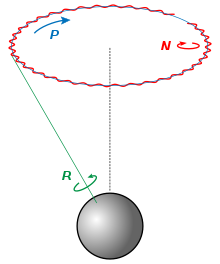Precession constant
The precession constant describes the angular velocity of the slow displacement of the earth's axis in relation to the fixed star sky due to the precession of the earth. The extension of the earth's axis runs through a circle in the fixed star sky; the earth as a whole performs a gyroscopic motion that is much slower than the earth's annual rotation around the sun. Meanwhile, the inclination of the earth's axis in relation to its orbit remains unchanged, and the earth's axis remains stationary at the north and south poles.
The cause of the precession of the earth are torques exerted by the gravitational forces of the sun and moon, because the earth is not perfectly spherical due to its flattening and thus an uneven distribution of its mass exists.
The precession of a further movement of the nutation , is superimposed .
values
Currently the constant is (according to Newcomb's precession formulas ):
- Lunisolar precession constant: 50.376 ... ″ per year ( lunar : effect of the moon, solar : ... the sun)
- general precession constant: 50.28 ... ″ per year (including the effect of all planets ).
impact
The displacement of the earth's axis causes a full, retrograde rotation of the intersection ( equinox line ) between the equatorial plane of the earth and the ecliptic within approx. 25,800 years ( cycle of precession ) . The spring equinox lies on this straight line and forms the basis of celestial coordinates. Therefore the precession of the earth changes the celestial coordinates and thus the star locations :
- in declination within a range of approximately ± 20 ″ per year (depending on the respective star location)
- in the right ascension by a time of 3 to 4 seconds per year.
change
The precession "constant" itself changes over the millennia because the lunar orbit also shifts slightly due to the change in its orbit and the tidal friction . These very long-period movements with around 40-100,000 years are in the order of magnitude of 0.01 ″ annually, so they can only be measured after a few decades.
The “precession constant” also fluctuates quasi-periodically with an average period of 41,000 years between two limit values due to the influence of the planets on the position of the ecliptic.
Coordinate transformation
For calculations for coordinate transformation, the following applies at the time given in Julian centuries :
- in radian measure :
- in arc seconds :
See also
- Gyroscopic laws, see Euler's equations (gyro theory)
Individual evidence
- ↑ N. Capitaine, PT Wallace, J. Chapront: Expressions for IAU 2000 precession quantities. (PDF) In: Astronomy Astrophysics. Retrieved November 26, 2016 ( doi: 10.1051 / 0004-6361: 20031539 ).



